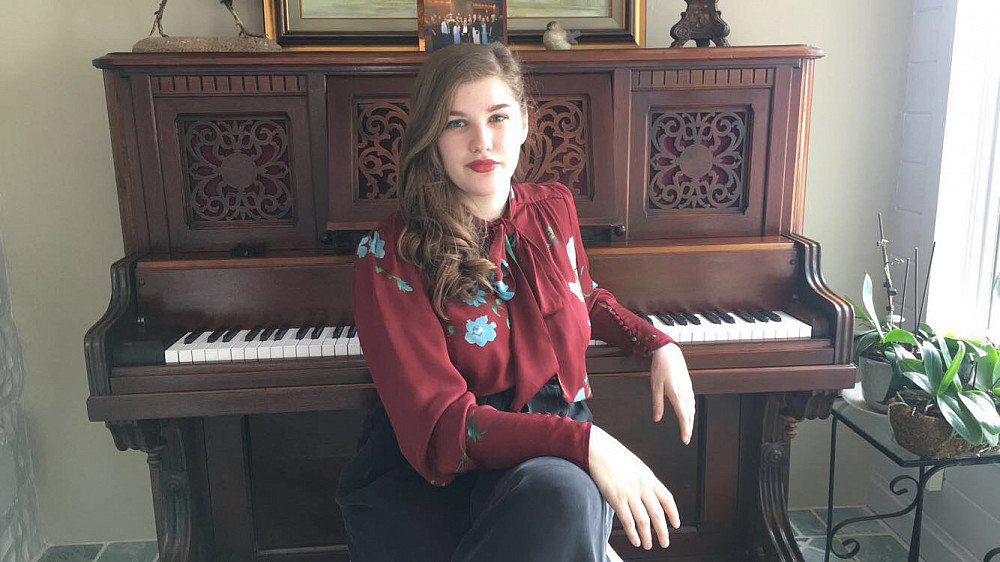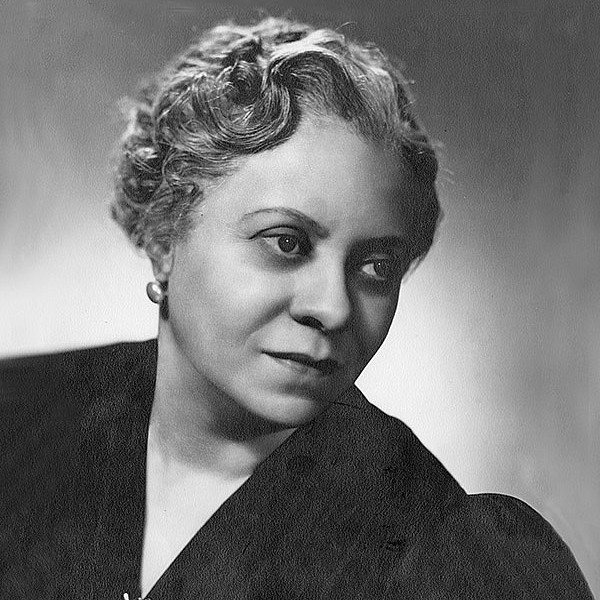News
Of Notes and Notations
Southwestern music literature major Katiebeth Brandt ’19 helps resurrect the long-archived manuscripts of composer Florence B. Price.
November 05, 2019
November 05, 2019

Last fall, in a course titled Music and Poetry in the Harlem Renaissance taught by Professor of Music and Margarett Root Brown Chair in Fine Arts Michael Cooper, six music majors were required to edit unknown, little-known, or unpublished compositions by African-American musician Florence B. Price. Their projects had to be “prepared from the manuscript according to source-critical editorial principles,” says Cooper. The students worked with archival materials from the University of Arkansas, in Fayetteville, to prepare a preface, a score, and a critical report for their chosen work. In completing their final projects, each student claimed copyright over their new scholarly editions of Price’s music.
Katiebeth Brandt ’19 chose a longer choral piece for the assignment titled “Bluebell,” with lyrics by Mary Rolofson Gamble. Then, in a move that Cooper says “went above and beyond the call of duty,” the Southwestern music literature major arranged for the work to be recorded by the choir at the University of Texas at San Antonio (UTSA) in December 2018 and then performed live on UTSA’s campus by the UTSA and Jack C. Hays High School choirs. The March 2019 performance not only constituted the posthumous premiere of Price’s “Bluebell”; it was the first time the work had been seen or heard in at least 60 years.
“I told the vocalists and pianist that they were making history. And everyone who performed was so amazing,” Brandt recalls, flush with excitement. “They did so well! Their voices filled the concert hall so wonderfully, the dynamics were there, and I felt like they felt it.”
For Brandt, who is now in her final semester at Southwestern, the performance had even greater significance because it combined three of her scholarly interests: musicology, social justice, and feminist studies.
For Brandt, who is now in her final semester at Southwestern, the performance had even greater significance because it combined three of her scholarly interests: musicology, social justice, and feminist studies. In addition to representing the work of Price, a female musical master of the socially progressive Harlem Renaissance, Brandt says that “the poet, the editor (me), the conductor, the pianist, and all eight vocalists were female. And out of the eight vocalists, all but one are queer, so they really felt it and connected to it … . I listen to that recording once a week. I’m so happy with it.”
Piecing together the pieces
The Southwestern student originally selected “Bluebell” to edit because of its air of mystery: it was unclear when the piece was composed, whether it had ever been performed in Price’s lifetime, and what genders the speaker and intended audience of the lyrics were supposed to represent—Brandt was intrigued by the potentially “homosocial underpinnings” of the work. She was also drawn to “Bluebell” because at the time of Cooper’s course, the music major was singing in a church choir, and although there were many piano pieces she could have chosen instead (as a performer, Price was primarily a pianist and organist), Brandt liked the idea of editing a work in which voice was the featured instrument.
Having the opportunity to hear female voices soar as the musicians performed Price’s piece gave “so much more life to it,” recalls Brandt.

Prior to the rehearsals, recording, and concert, the only way the young musicologist could hear Price’s piece was through the software she uses to edit and notate music—or, as Brandt puts it, “where magic happens.” Much of the young musicologist’s work includes what she calls “clicking and pointing,” or transcribing Price’s scores into the computer program, much like one might type handwritten notes into a word processor, which then allows for easier editing. The software allows her to plug in the number of measures, the key, the voice ranges, the instruments, the time signatures, and the notes. It’s a process that requires acute attention to detail and patience; it can take five hours to input just the notes of a 74-measure piece like “Summer Clouds,” another Price composition that Brandt professionally edited. Then, she inputs tempo markers (i.e., beats per minute) , dynamics (e.g., crescendo or decrescendo), phrase markings (e.g., slurs), and rhythms, layer after layer after layer. Afterward, she edits the digital version of the composition—because, like any human being, “composers do make mistakes,” she says—to make it performance ready.
Brandt makes such corrections, such as omitting an unintended sharp or flat marking, based on her knowledge of musical theory and practice, or what she refers to as “a lot of deductive reasoning.” She also checks the score by using the music-notation software’s playback feature. However, the program can only produce notes and replicate the sounds of instruments but not articulate song lyrics—which is why getting to hear “Bluebell” performed by a live choir was so exhilarating.
A passion for musicology
Brandt loves the work, and she’s known that she’s wanted to pursue musicology since her first year in college. She initially attended a small private Christian university in North Carolina, where she thought she’d major in international business. But after only six weeks, she abandoned the idea—“I had one business class and absolutely hated it!” she recalls—and switched to music. The change made sense: she’s played the flute and French horn (she proudly brandishes a tattoo of the latter on her left thigh) since middle school, and her favorite class was music history. However, like most undergraduate institutions, the school offered only music education and music performance as majors, and as she considered her career options down the road, she didn’t want to teach, nor did she want to endure the anxiety of performing. So she decided to transfer to Southwestern, where she could not only major in music literature but also study with Cooper.
“He’s a wonderful person,” says Brandt. “He’s really good about teaching history without any angles and not leaving anyone out. We need more people like him.” She credits the Southwestern music faculty with helping her transition as a transfer student and make the most out of her major. “I’ve stayed at SU for Dr. Cooper and Dr. Creel, my French horn teacher, because they’ve helped me beyond what anyone else could do. I personally adore Dr. Cooper and Dr. Creel, and they were exactly what I’ve needed in undergrad and as people.”
The respect is mutual: Cooper has been delighted to mentor Brandt and trumpet her accomplishments during her time at SU. “She’s smart, she’s diligent, and—surprisingly rare among music majors—she loves listening to classical music,” he says fondly.
Brandt confirms that passion for classical music, which she imbibes the way most consume pop music. It’s why she’s enjoyed studying world music, music history, music theory, and solfège (i.e., assigning syllables to notes of the musical scale for the purposes of composing and sight reading; if you were ever made to memorize and recite the indelible “Do–Re–Mi” from Rodgers and Hammerstein’s The Sound of Music like some of us were in fifth grade, you’ve dabbled in solfège).
Her studies have even taken her to Vienna, where she spent the spring 2018 semester engaged in a music research internship that she describes as “really, really awesome.” There, she visited the original manuscript of Gustav Mahler’s Symphony No. 3 at the Austrian National Library and even had tea at a café with Mahler’s granddaughter, Marina Fistoulari Mahler. She had the opportunity to practice her German and learned how to read Fraktur, a sixteenth-century calligraphic typeface, while translating and transcribing manuscripts. And she developed a critical edition of a composition by nineteenth-century Austrian organist Hans Rott, which Brandt says helped prepare her for the editorial work she’s been doing on Price since returning to Southwestern.

Approaching musical masters
Evaluating and interpreting the work of composers and bringing what they wrote to life clearly bring the SU musicologist great joy. She delights in researching the multiple copies of manuscripts that might need to be sifted through and selected for notating, correcting, and referencing. And she revels in interpreting whether the “layers of ink” in any given edition belong to the composer, to performers, or to editors who have previously worked on the piece. “I love getting these primary sources. From brain to pen, this is as close as I can ever get to these composers,” she says.
Her excitement only grows as, in a tumble of words and breathlessness, she talks about her Sarofim Student Travel Grant, which allowed her to visit the University of Arkansas archives this past June to explore more about Price’s work. There, while wearing a face mask to protect herself from documents that had been partially damaged by water damage and mold, Brandt was still happy getting to have direct contact with the composer’s diaries, photographs, correspondence, and, of course, musical scores.
As she completes her senior capstone—a third critical edition, this one of Price’s lengthy and complex Suite (Octet) for Brasses and Piano—Brandt is applying to Ph.D. programs in musicology. She looks forward to graduation, after which she hopes to spend several months traveling (a map of the world is tattooed on her other thigh). She’s considering taking a brief gap year (well, eight months) in Ireland or the Czech Republic or else researching the German Romantic composer Emilie Mayer back in Vienna. But wherever she lands, it won’t be long before Brandt will be back in the archives. “I love the manuscripts. I love the field research. I’m rewarded for doing what I find fascinating!” she adds, almost incredulously.
















